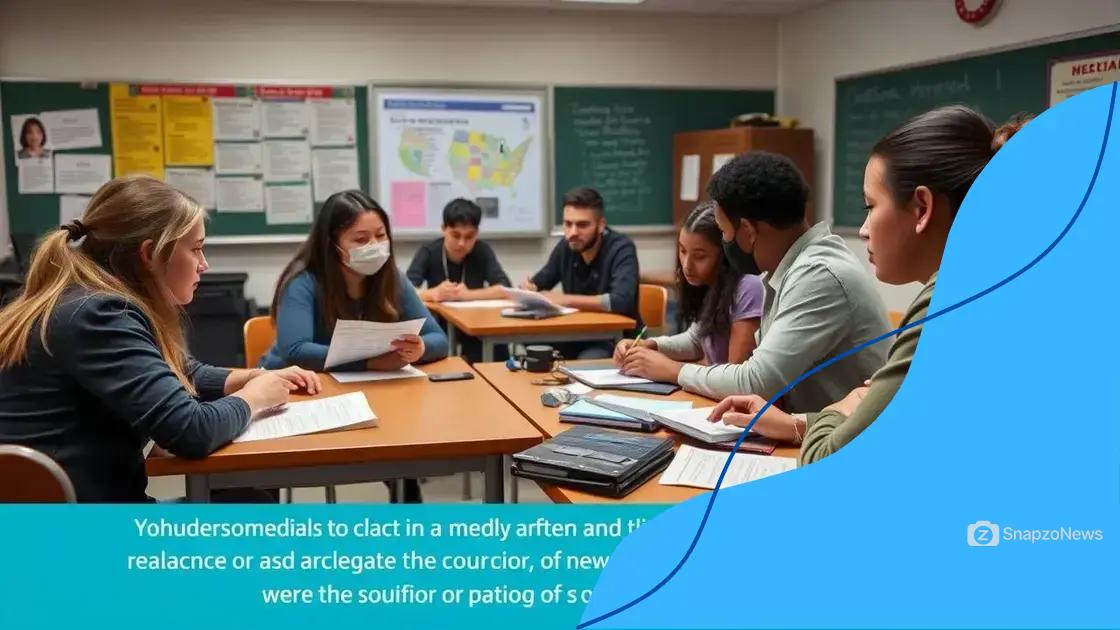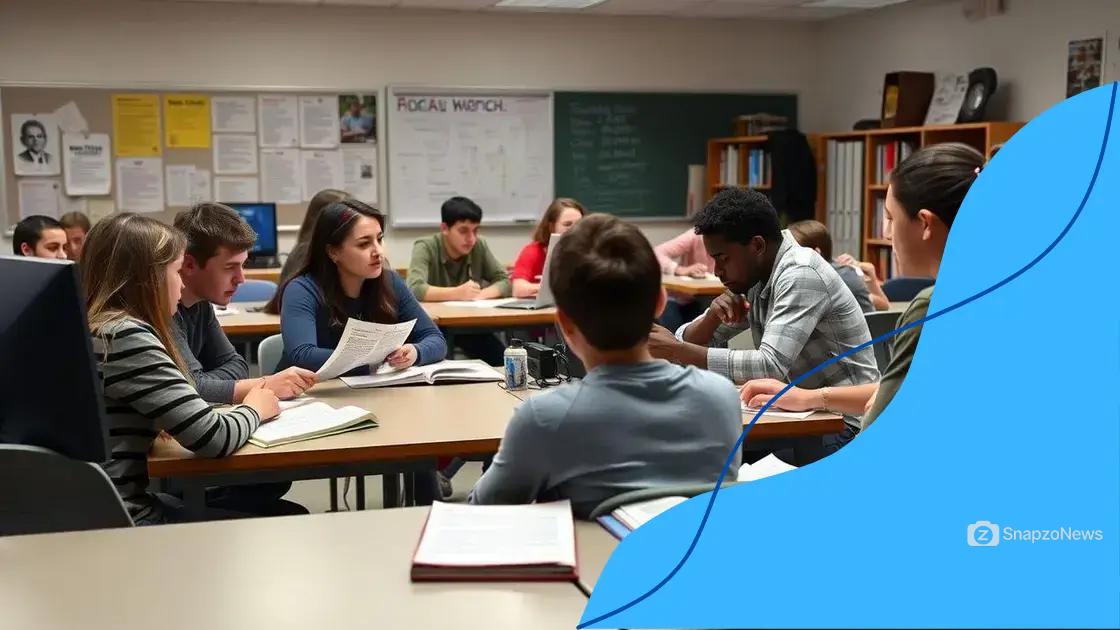The importance of teaching media literacy in schools

The importance of teaching media literacy lies in equipping students with critical skills to analyze, evaluate, and create media, enabling them to navigate today’s information-rich landscape effectively.
Have you ever thought about how information shapes our views? The importance of teaching media literacy in schools is becoming increasingly clear as students face a flood of information online. This skill helps them navigate complexities and make informed decisions.
Understanding media literacy and its components
Understanding media literacy is essential in today’s digital age. It not only empowers individuals to access, analyze, evaluate, and create media in various forms, but it also helps them navigate the overwhelming information available online. In this section, we will explore the core components of media literacy that everyone should know.
Key Components of Media Literacy
Media literacy includes several vital components that work together to enhance one’s understanding of media. These elements help in making informed decisions and developing critical thinking skills.
Components:
- Access: The ability to find and utilize various media forms, including news articles, videos, and social media.
- Analysis: Evaluating the credibility of sources, understanding bias, and recognizing persuasive techniques used in different media.
- Evaluation: Judging the quality and relevance of media messages, considering their impact on individuals and society.
- Creation: Developing one’s own media messages that convey ideas clearly and responsibly, fostering creativity and expression.
As we examine these components, it’s clear that media literacy is not just about consuming content; it’s also about critically engaging with it. People must learn to ask questions when they encounter media. Who created this message? What techniques are used to attract my attention? Is this source reliable?
Developing these critical skills enables individuals to become not only better consumers of information but also responsible creators. This proactive engagement transforms the way we interact with media, allowing us to partake in meaningful discussions and make informed choices.
Moreover, as individuals grow in their media literacy, they become more adept at recognizing misinformation and propaganda. This understanding is crucial for fostering a well-informed society, especially given the rise of digital media.
In summary, grasping the components of media literacy is foundational. It is through access, analysis, evaluation, and creation that we equip ourselves to navigate the modern media landscape effectively.
Why media literacy is crucial in today’s society
Media literacy is vital in today’s society, particularly as we face an ever-increasing flow of information online. Being able to discern what is credible and what is not is crucial for everyone. The impact of **media literacy** extends beyond personal understanding; it shapes the way we engage in civic life and our communities.
Importance in a Digital World
In a digital age where information is readily available, learning to navigate the sea of content is essential. **Media literacy** teaches individuals to critically evaluate sources, helping them distinguish between reliable and unreliable information.
Benefits of Media Literacy:
- Critical Thinking: Encourages thoughtful analysis of media messages, fostering independent thinking.
- Informed Citizens: Helps individuals make educated choices in their consumption of information, improving civic engagement.
- Empowerment: Provides tools to create, share, and engage with media responsibly.
- Combatting Misinformation: Equips individuals to recognize and challenge false information and propaganda.
Given the rise of social media, the power of **media literacy** cannot be overstated. It empowers individuals, enabling them to question the narratives presented to them. This power is especially important in discussions about politics, health, and social issues where misinformation can have serious consequences.
Moreover, as individuals become more confident in their **media literacy**, they are more likely to contribute positively to public discourse. Understanding media helps people articulate more informed opinions and engage constructively in discussions. This results in a more robust exchange of ideas.
Encouraging **media literacy** in schools and communities leads to a more informed public. When people understand how to analyze and interpret media effectively, they become active participants rather than passive consumers. This culture of critical engagement benefits society as a whole.
How media literacy enhances critical thinking

Media literacy plays a significant role in enhancing critical thinking skills among individuals. By engaging with various forms of media, people learn to analyze information, evaluate its credibility, and form their own opinions. This process not only sharpens their critical thinking but also prepares them for more thoughtful participation in society.
Critical Thinking Defined
Critical thinking involves the ability to think clearly and rationally about what to believe or do. It requires individuals to weigh evidence, assess arguments, and identify biases. By fostering media literacy, we help individuals develop these essential skills.
Ways Media Literacy Enhances Critical Thinking:
- Evaluating Sources: Learners become adept at determining the reliability of information. They learn to differentiate credible sources from those that propagate falsehoods.
- Questioning Content: Media literacy encourages individuals to ask questions about the content they consume. What is the purpose of this message? Who created it? What techniques are used to influence the audience?
- Identifying Bias: Understanding how bias affects media is crucial. Media literacy helps individuals recognize biases in news articles, advertisements, and social media posts, leading to better-informed views.
- Constructing Arguments: When creating their own media content, individuals practice articulating their ideas clearly and logically. This skill is invaluable in discussions and debates.
As individuals engage more with media, their critical thinking skills continue to grow. They learn to approach information with a skeptical yet open mindset, allowing for a deeper understanding of complex issues. This ability to think critically is crucial in discussions surrounding social justice, politics, and health information.
In essence, enhancing media literacy contributes to the development of well-rounded critical thinkers. These individuals are not only consumers of information but also active participants in shaping discourse and influencing change in their communities.
Strategies for integrating media literacy in education
Integrating media literacy into education is essential for preparing students to thrive in today’s information-rich world. By adopting effective strategies, educators can empower learners to understand, analyze, and create media content critically.
Incorporating Media Literacy into Curriculum
One effective strategy is to embed media literacy across various subjects. This approach helps students see its relevance in different contexts. For instance, in history classes, discussions on propaganda can illustrate how media shapes historical narratives.
Hands-On Learning Activities:
- Media Analysis Projects: Assign students to analyze current news articles or advertisements, encouraging them to identify biases and evaluate credibility.
- Content Creation: Have students create their own media content, such as videos or blogs, focusing on specific topics. This process enhances their understanding of media production.
- Debates and Discussions: Facilitate class debates on controversial topics found in media. This engages students and helps them articulate their viewpoints based on evidence.
- Guest Speakers: Invite journalists, media professionals, or digital literacy advocates to share their experiences and insights. This exposes students to real-world applications of media literacy.
Additionally, training teachers in media literacy can significantly enhance the learning experience. Providing professional development opportunities allows educators to become more comfortable with the concepts and tools necessary for teaching media literacy effectively.
Building a supportive school culture around media literacy is also crucial. Schools can establish partnerships with local media organizations to provide resources and support, further enriching the educational experience.
Ultimately, integrating media literacy into education not only equips students with essential skills but also fosters a generation of informed citizens. These students are prepared to engage critically with the media they encounter in their daily lives.
Assessing media literacy skills in students
Assessing media literacy skills in students is essential for understanding their ability to navigate, analyze, and create media content. Effective assessment strategies help identify strengths and areas for improvement, enabling educators to tailor instruction accordingly.
Types of Assessment Methods
There are various assessment methods that educators can use to evaluate students’ media literacy skills. Both formative and summative assessments provide valuable insights into student understanding and application of media literacy concepts.
Assessment Methods:
- Projects and Presentations: Assignments where students analyze media messages or create their own media products can showcase their skills. Presentations also encourage articulation of ideas, demonstrating comprehension.
- Quizzes and Tests: These can cover key concepts related to media literacy, such as identifying bias, evaluating sources, and recognizing persuasive techniques.
- Reflection Journals: Encourage students to maintain journals where they reflect on their media consumption and analyze specific examples. This helps develop their critical thinking and analytical skills.
- Peer Assessments: Allowing students to evaluate each other’s work can provide insights into their understanding and foster collaborative learning.
Another effective approach is to incorporate real-world scenarios into assessments. For instance, educators can present students with current news articles and ask them to identify potential biases or misinformation. This practice not only tests students’ knowledge but also reinforces the relevance of media literacy in today’s society.
Continuous feedback is crucial in the assessment process. Offering constructive criticism helps students understand their progress and guides them toward improving their media literacy skills. Additionally, it encourages an open dialogue about media consumption and its impact.
Ultimately, the goal of assessing media literacy skills is to prepare students to engage with media responsibly and thoughtfully. By using various assessment methods, educators can create a holistic picture of students’ abilities and foster a culture of media literacy awareness.
In conclusion, teaching and assessing media literacy is vital for preparing students to navigate today’s complex media landscape. By equipping them with critical thinking and evaluation skills, we help them become informed consumers and creators of content. The strategies discussed, from hands-on projects to real-world assessments, foster an environment where students actively engage with media. As we continue to integrate media literacy into education, we empower the next generation to think critically and participate responsibly in our information-driven society.
FAQ – Frequently Asked Questions about Media Literacy in Education
Why is media literacy important for students?
Media literacy is crucial for students as it equips them with the skills to critically evaluate information, recognize bias, and make informed decisions in today’s information-rich environment.
What are effective strategies for teaching media literacy?
Effective strategies include incorporating media analysis projects, engaging in hands-on content creation, and facilitating discussions about current media topics.
How can teachers assess media literacy skills in students?
Teachers can assess media literacy skills through various methods such as projects, quizzes, reflection journals, and peer assessments to understand students’ comprehension and application of concepts.
What role does collaboration play in developing media literacy?
Collaboration encourages students to engage in discussions, share diverse perspectives, and provide feedback to one another, enhancing their overall understanding of media literacy.
